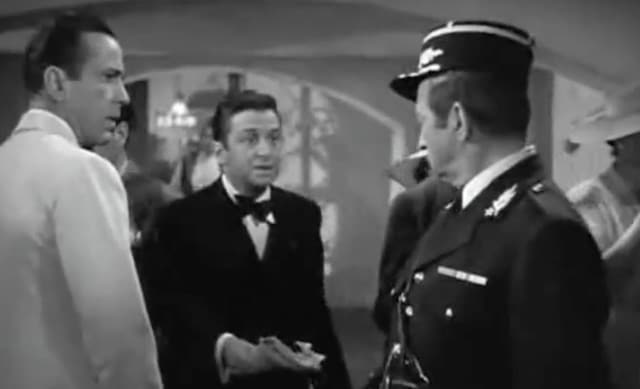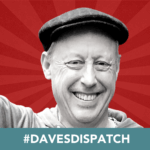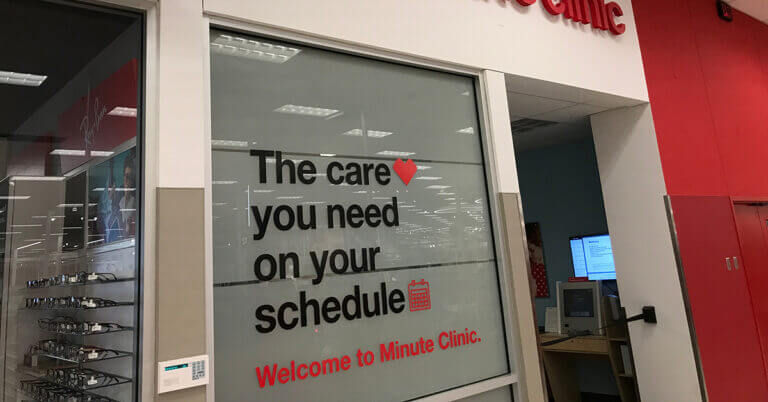September 7, 2021

Gaming Payment at the Healthcare Casino
In the classic movie drama “Casablanca,” cynical restaurateur Rick Blaine (Humphrey Bogart) operates the rollicking Rick’s Café Américain in occupied French Morocco during the early years of World War II. France’s Vichy government controlled Morocco at that time and was collaborating with the Nazis in their quest to conquer North Africa.

Louis Renault (Claude Rains), right, informs Rick Blaine that he is “shocked, shocked” to learn that gambling is going on there. (©Warner Brothers Pictures)
After reports that resistance leader Victor Laszlo was on site, Nazi Major Heinrich Strasser orders police captain Louis Renault (Claude Rains) to clear the premises. In an iconic scene, Louis tells Rick that he’s closing his establishment because he’s “shocked, shocked to learn there’s gambling in the cafe” just as a casino worker hands Louis his winnings.
I was reminded of Captain Louis’ feigned surprise and indignance while reading the New York Times recent investigative report on hospitals’ noncompliance with the federal government’s new pricing transparency rules. The article carries this provocative title, “Hospitals and Insurers Didn’t Want You to See These Prices. Here’s Why.”
There appears to be no inherent logic to hospital prices. Not only do different insurers pay different prices for the same treatment at the same hospitals, but the same insurer pays different prices for the same treatment within the different plans they offer. Even more surprising, the prices paid by health insurers are often higher than cash prices paid by individuals.
Here’s an example of pricing absurdity highlighted by the New York Times. The price of a pregnancy test at the Hospital of the University of Pennsylvania costs $18 for patients insured by Blue Cross patients in Pennsylvania, $58 for Blue Cross HMO patients in New Jersey, $93 for Blue Cross PPO patients in New Jersey and only $10 for patients without insurance.
The Times article includes numerous quotes from hospitals and insurers assuring their commitment to price transparency and value-based care delivery even as their actions suggest the contrary. In short, these industry insiders are “shocked, shocked” to learn that there are wide pricing discrepancies between Medicare, cash and insured prices for identical procedures.
Researchers are now able to unearth these pricing discrepancies because a new federal rule requires hospitals to post prices they’ve negotiated with health insurance companies for specific procedures. Industry trade associations called the new rule unconstitutional, fought it in court and lost. The new rule went into effect January 1, 2021.
Some hospitals are reluctantly complying with the new rule. Others are burying prices with massive files that are almost impossible for consumers to navigate. Still others are simply refusing to comply and paying fines instead. In response to industry foot-dragging, CMS has just increased the maximum annual penalty from $109,500 to $2,007,500 for noncompliant hospitals with more than ten beds.
Why the resistance? Shouldn’t hospitals and health insurers want their customers to know in advance what procedures should cost? You might think so, but differential pricing for identical procedures has been a unique, deviant and deeply entrenched feature of U.S. healthcare for decades
Despite assurances to the contrary, right now neither patients nor self-insured employers can know in advance whether they’re receiving competitive prices. Commercial insurers often pay prices that are multiples higher than Medicare, even for routine procedures. The New York Times reports, for example, that many commercial insurers pay more than four times the Medicare rate for routine colonoscopies and more than ten times the Medicare rate for M.R.I scans.
Despite appearances to the contrary, there is a logic to the prices hospitals and insurers negotiate with one another for specific treatments. These prices reflect each party’s relative negotiating leverage. Market power, not the underlying costs of providing the treatments, is the primary driver of hospital prices.
Opaque pricing enables providers and payers to optimize revenues and profits while giving the appearance of hard bargaining between them. This is the principal reason that commercial health insurance premiums have grown at almost twice the rate of medical inflation since the late 1990s.
High treatment prices are creating a greater financial burden for patients, particularly those enrolled in high deductible health plans (HDHPs). Under HDHPs, patients are responsible for a higher percentage of the final bill. The higher the bill price, the more consumers pay.
At 4sight Health, payment variation is a frequent focus of our research and topic for our content. Dave Burda’s recent “Hospital Spotting” commentary explored how the new price transparency rules have spawned a cottage industry. Using his Columbo-like investigative skills, Dave found a flood of new reports on hospital prices. They largely conclude that hospitals are doing a terrible job of complying with the new rules.
In our August 6th 4sight Friday podcast, Dave, Julie Murchinson and I discussed why it’s so hard for hospitals to comply with the new rules. It is an entertaining show. Dave described hospitals’ compliance efforts as “pathetic.” Julie discovered that the price of a diagnostic colonoscopy in Virginia ranges between $208 and $10,563. I sang a verse about a hospital bill from the August 4sight Health song, “Healthcare Dystopia: A Patient’s Lament.”
At the end of “Casablanca,” Captain Louis first, and then Nazi Major Strasser, confront Rick at the airport as the plane carrying fugitive Victor Laszlo prepares to take off. Rick shoots and kills Strasser. Rather than arrest Rick, Louis orders his arriving officers to “round up the usual suspects.” Louis persuades Rick to leave Casablanca with him and join the French resistance. As the film ends, Rick famously says, “Louis, I think this is the beginning of a beautiful friendship.”
If hard-bitten cynics like Rick and Louis can become patriots, hard-core fee-for-service proponents can join the movement to bring value and rational pricing to healthcare services. There is a significant market opportunity for enlightened health systems and insurers to step out of the shadows and embrace price transparency. It would be the beginning of a beautiful and productive relationship with consumers.
 Read all dispatches from Dave Johnson here.
Read all dispatches from Dave Johnson here.
Check out all the 4sight Health songs here.





